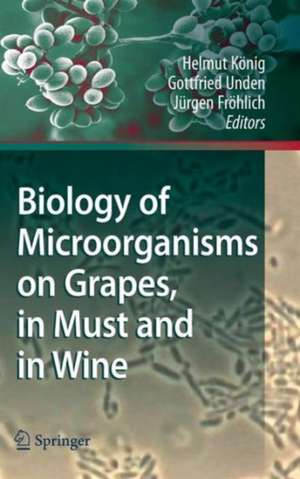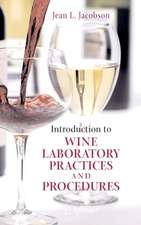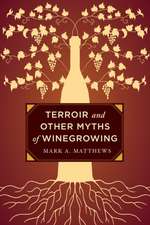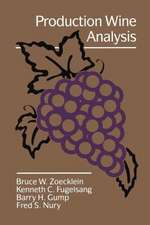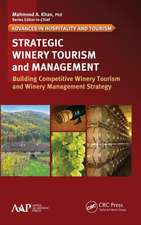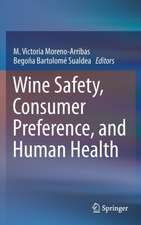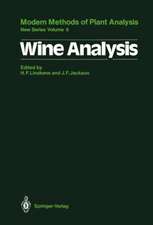Biology of Microorganisms on Grapes, in Must and in Wine
Editat de Helmut König, Gottfried Unden, Jürgen Fröhlichen Limba Engleză Hardback – 15 ian 2009
| Toate formatele și edițiile | Preț | Express |
|---|---|---|
| Paperback (2) | 1552.43 lei 38-44 zile | |
| Springer – 19 oct 2010 | 1552.43 lei 38-44 zile | |
| Springer International Publishing – 24 mai 2018 | 1673.13 lei 6-8 săpt. | |
| Hardback (2) | 1566.10 lei 6-8 săpt. | |
| Springer Berlin, Heidelberg – 15 ian 2009 | 1566.10 lei 6-8 săpt. | |
| Springer International Publishing – 10 noi 2017 | 1679.42 lei 6-8 săpt. |
Preț: 1566.10 lei
Preț vechi: 1909.88 lei
-18% Nou
Puncte Express: 2349
Preț estimativ în valută:
299.67€ • 312.88$ • 248.02£
299.67€ • 312.88$ • 248.02£
Carte tipărită la comandă
Livrare economică 05-19 aprilie
Preluare comenzi: 021 569.72.76
Specificații
ISBN-13: 9783540854623
ISBN-10: 3540854622
Pagini: 540
Ilustrații: XVIII, 522 p.
Dimensiuni: 155 x 235 x 38 mm
Greutate: 1.07 kg
Ediția:2009
Editura: Springer Berlin, Heidelberg
Colecția Springer
Locul publicării:Berlin, Heidelberg, Germany
ISBN-10: 3540854622
Pagini: 540
Ilustrații: XVIII, 522 p.
Dimensiuni: 155 x 235 x 38 mm
Greutate: 1.07 kg
Ediția:2009
Editura: Springer Berlin, Heidelberg
Colecția Springer
Locul publicării:Berlin, Heidelberg, Germany
Public țintă
ResearchCuprins
Diversity of Microorganisms.- Lactic Acid Bacteria.- Acetic Acid Bacteria.- Yeasts.- Fungi of Grapes.- Phages of Yeast and Bacteria.- Primary and Energy Metabolism.- Sugar Metabolism by Saccharomyces and non-Saccharomyces Yeasts.- Metabolism of Sugars and Organic Acids by Lactic Acid Bacteria from Wine and Must.- Transport of Sugars and Sugar Alcohols by Lactic Acid Bacteria.- Secondary Metabolism.- Amino Acid Metabolisms and Production of Biogenic Amines and Ethyl Carbamate.- Usage and Formation of Sulphur Compounds.- Microbial Formation and Modification of Flavor and Off-Flavor Compounds in Wine.- Pyroglutamic Acid: A Novel Compound in Wines.- Polysaccharide Production by Grapes, Must, and Wine Microorganisms.- Exoenzymes of Wine Microorganisms.- Stimulaling and Inhibitary Growth Factors.- Physical and Chemical Stress Factors in Yeast.- Physical and Chemical Stress Factors in Lactic Acid Bacteria.- Influence of Phenolic Compounds and Tannins on Wine-Related Microorganisms.- Microbial Interactions.- Molecular Biology and Regulation.- Genomics of Oenococcus oeni and Other Lactic Acid Bacteria.- Genome of Saccharomyces cerevisiae and Related Yeasts.- The Genome of Acetic Acid Bacteria.- Systems Biology as a Platform for Wine Yeast Strain Development.- Plasmids from Wine-Related Lactic Acid Bacteria.- Rapid Detection and Identification with Molecular Methods.- Maintenance of Wine-Associated Microorganisms.- DNA Arrays.- Application of Yeast and Bacteria as Starter Cultures.
Recenzii
From the reviews:
"This compilation is outstanding. Forty-nine contributors from eight countries offer recent information on the microbiology of wine production, covering specific topics in both breadth and depth. … each of the book’s 27 chapters stands alone, there is excellent continuity between chapters to give readers a good overview of the subject. … The text contains detailed tabular information and clear, readily understood figures. … This is excellent scientific reporting. Summing Up: Highly recommended. Lower-division undergraduates through professionals and practitioners." (G. S. Howell, Choice, Vol. 46 (11), 2009)
"This compilation is outstanding. Forty-nine contributors from eight countries offer recent information on the microbiology of wine production, covering specific topics in both breadth and depth. … each of the book’s 27 chapters stands alone, there is excellent continuity between chapters to give readers a good overview of the subject. … The text contains detailed tabular information and clear, readily understood figures. … This is excellent scientific reporting. Summing Up: Highly recommended. Lower-division undergraduates through professionals and practitioners." (G. S. Howell, Choice, Vol. 46 (11), 2009)
Caracteristici
This is the first book with a clear and exclusive focus on the different biological aspects of wine-related microbes The editors and authors are well-known experts, researchers and teachers in wine science, oenology and viticulture from different wine-growing countries Helmut König, Institute of Microbiology and Wine Research, Johannes Gutenberg University of Mainz, is involved in the International Wine Education Program of the Global Network "Great Wine Capitals" Includes supplementary material: sn.pub/extras
Descriere
Descriere de la o altă ediție sau format:
The ancient beverage wine is the result of the fermentation of grape must. This n- urally and fairly stable product has been and is being used by many human societies as a common or enjoyable beverage, as an important means to improve the quality of drinking water in historical times, as therapeutical agent, and as a religious symbol. During the last centuries, wine has become an object of scientific interest. In this respect different periods may be observed. At first, simple observations were recorded, and subsequently, the chemical basis and the involvement of microorg- isms were elucidated. At a later stage, the scientific work led to the analysis of the many minor and trace compounds in wine, the detection and understanding of the biochemical reactions and processes, the diversity of microorganisms involved, and the range of their various activities. In recent years, the focus shifted to the genetic basis of the microorganisms and the molecular aspects of the cells, including metabolism, membrane transport, and regulation. These different stages of wine research were determined by the scientific methods that were known and available at the respective time. The recent “molecular” approach is based on the analysis of the genetic code and has led to significant results that were not even imaginable a few decades ago. This new wealth of information is being presented in the Biology of Microorganisms on Grapes, in Must, and in Wine.
The ancient beverage wine is the result of the fermentation of grape must. This n- urally and fairly stable product has been and is being used by many human societies as a common or enjoyable beverage, as an important means to improve the quality of drinking water in historical times, as therapeutical agent, and as a religious symbol. During the last centuries, wine has become an object of scientific interest. In this respect different periods may be observed. At first, simple observations were recorded, and subsequently, the chemical basis and the involvement of microorg- isms were elucidated. At a later stage, the scientific work led to the analysis of the many minor and trace compounds in wine, the detection and understanding of the biochemical reactions and processes, the diversity of microorganisms involved, and the range of their various activities. In recent years, the focus shifted to the genetic basis of the microorganisms and the molecular aspects of the cells, including metabolism, membrane transport, and regulation. These different stages of wine research were determined by the scientific methods that were known and available at the respective time. The recent “molecular” approach is based on the analysis of the genetic code and has led to significant results that were not even imaginable a few decades ago. This new wealth of information is being presented in the Biology of Microorganisms on Grapes, in Must, and in Wine.
Notă biografică
Prof. Dr. Helmut König,
Johannes Gutenberg University,
Inst. Microbiology and Wine Research,
Mainz,
Germany
Dr. Jürgen Fröhlich,
Erbslöh Geisenheim AG,
Geisenheim,
Germany
Prof. Dr. Gottfried Unden,
Johannes Gutenberg University,
Inst. Microbiology and Wine Research,
Mainz,
Germany
Textul de pe ultima copertă
The second edition of the book begins with the description of the diversity of wine-related microorganisms, followed by an outline of their primary and energy metabolism. Subsequently, important aspects of the secondary metabolism are dealt with, since these activities have an impact on wine quality and off-flavour formation. Then chapters about stimulating and inhibitory growth factors follow. This knowledge is helpful for the growth management of different microbial species. The next chapters focus on the application of the consolidated findings of molecular biology and regulation the functioning of regulatory cellular networks, leading to a better understanding of the phenotypic behaviour of the microbes in general and especially of the starter cultures as well as of stimulatory and inhibitory cell-cell interactions during wine making. In the last part of the book, a compilation of modern methods complete the understanding of microbial processes during the conversion of must towine.
This broad range of topics about the biology of the microbes involved in the vinification process could be provided in one book only because of the input of many experts from different wine-growing countries.
